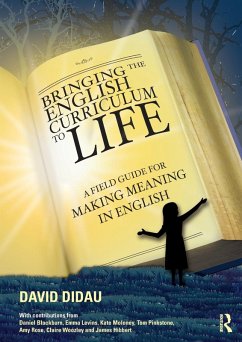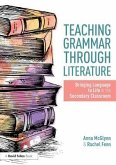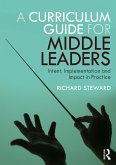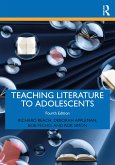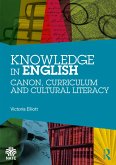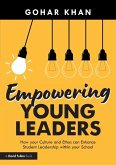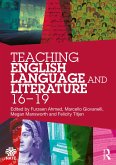- Broschiertes Buch
- Merkliste
- Auf die Merkliste
- Bewerten Bewerten
- Teilen
- Produkt teilen
- Produkterinnerung
- Produkterinnerung
This book builds on David Didauâ s groundbreaking book Making Meaning in English by showing how the principles of the original book can be applied in schools and classrooms. It offers a fully resourced English curriculum packed with teaching suggestions and examples of high-quality practice.
Andere Kunden interessierten sich auch für
![Teaching Grammar through Literature Teaching Grammar through Literature]() Anna McGlynn (UK Weald of Kent Grammar School)Teaching Grammar through Literature34,99 €
Anna McGlynn (UK Weald of Kent Grammar School)Teaching Grammar through Literature34,99 €![A Curriculum Guide for Middle Leaders A Curriculum Guide for Middle Leaders]() Richard Steward (The Woodroffe School Headteacher)A Curriculum Guide for Middle Leaders29,99 €
Richard Steward (The Woodroffe School Headteacher)A Curriculum Guide for Middle Leaders29,99 €![Teaching Literature to Adolescents Teaching Literature to Adolescents]() Richard BeachTeaching Literature to Adolescents54,99 €
Richard BeachTeaching Literature to Adolescents54,99 €![Knowledge in English Knowledge in English]() Victoria Elliott (UK University of Oxford)Knowledge in English167,99 €
Victoria Elliott (UK University of Oxford)Knowledge in English167,99 €![Knowledge in English Knowledge in English]() Victoria Elliott (UK University of Oxford)Knowledge in English50,99 €
Victoria Elliott (UK University of Oxford)Knowledge in English50,99 €![Empowering Young Leaders Empowering Young Leaders]() Gohar KhanEmpowering Young Leaders30,99 €
Gohar KhanEmpowering Young Leaders30,99 €![Teaching English Language and Literature 16-19 Teaching English Language and Literature 16-19]() Teaching English Language and Literature 16-1925,99 €
Teaching English Language and Literature 16-1925,99 €-
-
-
This book builds on David Didauâ s groundbreaking book Making Meaning in English by showing how the principles of the original book can be applied in schools and classrooms. It offers a fully resourced English curriculum packed with teaching suggestions and examples of high-quality practice.
Produktdetails
- Produktdetails
- Verlag: Taylor & Francis Ltd
- Seitenzahl: 164
- Erscheinungstermin: 12. April 2024
- Englisch
- Abmessung: 297mm x 210mm x 9mm
- Gewicht: 502g
- ISBN-13: 9781032596563
- ISBN-10: 1032596562
- Artikelnr.: 69432849
- Herstellerkennzeichnung
- Libri GmbH
- Europaallee 1
- 36244 Bad Hersfeld
- gpsr@libri.de
- Verlag: Taylor & Francis Ltd
- Seitenzahl: 164
- Erscheinungstermin: 12. April 2024
- Englisch
- Abmessung: 297mm x 210mm x 9mm
- Gewicht: 502g
- ISBN-13: 9781032596563
- ISBN-10: 1032596562
- Artikelnr.: 69432849
- Herstellerkennzeichnung
- Libri GmbH
- Europaallee 1
- 36244 Bad Hersfeld
- gpsr@libri.de
David Didau is Senior Lead Practitioner for English at Ormiston Academies Trust as well as the author of several books coving a wide range of education topics.
Section 1: Intent: Specifying the curriculum
1.1 What we mean by 'intent'
1.2 Curriculum as conversation
1.3 The 'knowledge turn' in English
1.4 The problem with thinking of English as 'skills based'
1.5 Why do so many students fail to make progress?
1.6 Specifying curriculum concepts in English
1.7 Ambitious for all
1.8 Coherent planning and sequencing
1.9 Designed for students with SEND
1.10 Broad and balanced
1.11 Core and hinterland
1.12 Personal development
1.13 GCSE ready
Intent: key points
Section 2: Implementation: Communicating the curriculum
2.1 What we mean by 'implementation'
2.2 Gapless instruction
2.3 Success before struggle
2.4 Five core pedagogies
2.5 Mini-white boards
2.6 Regular retrieval practice
2.7 Vocabulary instruction
2.8 Couch to 5k writing
2.9 Reading for meaning
2.10 Structured discussion
2.11 Teaching tenor, vehicle and ground
2.12 Marking books
2.13 Homework
2.14 Using visualisers
2.15 Student anthologies
2.16 Teacher guides
2.17 The importance of co-planning
2.18 Scaling across multiple schools
Implementation: key points
Section 3: Impact: Assessing the curriculum
3.1 What we mean by 'impact'
3.2 Using the curriculum as a progression model
3.3 The madness of flightpaths
3.4 The problem with Age Related Expectations
3.5 Should we grade students?
3.6 Curriculum Related Expectations
3.7 What is assessment for?
3.8 Mastery assessment
3.9 Problems with assessing English
3.10 Formative assessment and identifying gaps
3.11 Hinge point questions
3.12 The role of numbers
3.13 Summative assessment and comparative judgement
3.14 The need for discriminatory assessment
3.15 Reporting to different audiences
Impact: key points
Section 4: The curriculum in detail
4.1 Year 7 - The origins of literature
4.2 Year 8 - The development of form
4.3 Year 9 - Into the world
4.4 The KS4 curriculum
4.4.1 Teaching AQA's Power & Conflict poetry cluster
4.4.3 A note about GCSE reform
1.1 What we mean by 'intent'
1.2 Curriculum as conversation
1.3 The 'knowledge turn' in English
1.4 The problem with thinking of English as 'skills based'
1.5 Why do so many students fail to make progress?
1.6 Specifying curriculum concepts in English
1.7 Ambitious for all
1.8 Coherent planning and sequencing
1.9 Designed for students with SEND
1.10 Broad and balanced
1.11 Core and hinterland
1.12 Personal development
1.13 GCSE ready
Intent: key points
Section 2: Implementation: Communicating the curriculum
2.1 What we mean by 'implementation'
2.2 Gapless instruction
2.3 Success before struggle
2.4 Five core pedagogies
2.5 Mini-white boards
2.6 Regular retrieval practice
2.7 Vocabulary instruction
2.8 Couch to 5k writing
2.9 Reading for meaning
2.10 Structured discussion
2.11 Teaching tenor, vehicle and ground
2.12 Marking books
2.13 Homework
2.14 Using visualisers
2.15 Student anthologies
2.16 Teacher guides
2.17 The importance of co-planning
2.18 Scaling across multiple schools
Implementation: key points
Section 3: Impact: Assessing the curriculum
3.1 What we mean by 'impact'
3.2 Using the curriculum as a progression model
3.3 The madness of flightpaths
3.4 The problem with Age Related Expectations
3.5 Should we grade students?
3.6 Curriculum Related Expectations
3.7 What is assessment for?
3.8 Mastery assessment
3.9 Problems with assessing English
3.10 Formative assessment and identifying gaps
3.11 Hinge point questions
3.12 The role of numbers
3.13 Summative assessment and comparative judgement
3.14 The need for discriminatory assessment
3.15 Reporting to different audiences
Impact: key points
Section 4: The curriculum in detail
4.1 Year 7 - The origins of literature
4.2 Year 8 - The development of form
4.3 Year 9 - Into the world
4.4 The KS4 curriculum
4.4.1 Teaching AQA's Power & Conflict poetry cluster
4.4.3 A note about GCSE reform
Section 1: Intent: Specifying the curriculum
1.1 What we mean by 'intent'
1.2 Curriculum as conversation
1.3 The 'knowledge turn' in English
1.4 The problem with thinking of English as 'skills based'
1.5 Why do so many students fail to make progress?
1.6 Specifying curriculum concepts in English
1.7 Ambitious for all
1.8 Coherent planning and sequencing
1.9 Designed for students with SEND
1.10 Broad and balanced
1.11 Core and hinterland
1.12 Personal development
1.13 GCSE ready
Intent: key points
Section 2: Implementation: Communicating the curriculum
2.1 What we mean by 'implementation'
2.2 Gapless instruction
2.3 Success before struggle
2.4 Five core pedagogies
2.5 Mini-white boards
2.6 Regular retrieval practice
2.7 Vocabulary instruction
2.8 Couch to 5k writing
2.9 Reading for meaning
2.10 Structured discussion
2.11 Teaching tenor, vehicle and ground
2.12 Marking books
2.13 Homework
2.14 Using visualisers
2.15 Student anthologies
2.16 Teacher guides
2.17 The importance of co-planning
2.18 Scaling across multiple schools
Implementation: key points
Section 3: Impact: Assessing the curriculum
3.1 What we mean by 'impact'
3.2 Using the curriculum as a progression model
3.3 The madness of flightpaths
3.4 The problem with Age Related Expectations
3.5 Should we grade students?
3.6 Curriculum Related Expectations
3.7 What is assessment for?
3.8 Mastery assessment
3.9 Problems with assessing English
3.10 Formative assessment and identifying gaps
3.11 Hinge point questions
3.12 The role of numbers
3.13 Summative assessment and comparative judgement
3.14 The need for discriminatory assessment
3.15 Reporting to different audiences
Impact: key points
Section 4: The curriculum in detail
4.1 Year 7 - The origins of literature
4.2 Year 8 - The development of form
4.3 Year 9 - Into the world
4.4 The KS4 curriculum
4.4.1 Teaching AQA's Power & Conflict poetry cluster
4.4.3 A note about GCSE reform
1.1 What we mean by 'intent'
1.2 Curriculum as conversation
1.3 The 'knowledge turn' in English
1.4 The problem with thinking of English as 'skills based'
1.5 Why do so many students fail to make progress?
1.6 Specifying curriculum concepts in English
1.7 Ambitious for all
1.8 Coherent planning and sequencing
1.9 Designed for students with SEND
1.10 Broad and balanced
1.11 Core and hinterland
1.12 Personal development
1.13 GCSE ready
Intent: key points
Section 2: Implementation: Communicating the curriculum
2.1 What we mean by 'implementation'
2.2 Gapless instruction
2.3 Success before struggle
2.4 Five core pedagogies
2.5 Mini-white boards
2.6 Regular retrieval practice
2.7 Vocabulary instruction
2.8 Couch to 5k writing
2.9 Reading for meaning
2.10 Structured discussion
2.11 Teaching tenor, vehicle and ground
2.12 Marking books
2.13 Homework
2.14 Using visualisers
2.15 Student anthologies
2.16 Teacher guides
2.17 The importance of co-planning
2.18 Scaling across multiple schools
Implementation: key points
Section 3: Impact: Assessing the curriculum
3.1 What we mean by 'impact'
3.2 Using the curriculum as a progression model
3.3 The madness of flightpaths
3.4 The problem with Age Related Expectations
3.5 Should we grade students?
3.6 Curriculum Related Expectations
3.7 What is assessment for?
3.8 Mastery assessment
3.9 Problems with assessing English
3.10 Formative assessment and identifying gaps
3.11 Hinge point questions
3.12 The role of numbers
3.13 Summative assessment and comparative judgement
3.14 The need for discriminatory assessment
3.15 Reporting to different audiences
Impact: key points
Section 4: The curriculum in detail
4.1 Year 7 - The origins of literature
4.2 Year 8 - The development of form
4.3 Year 9 - Into the world
4.4 The KS4 curriculum
4.4.1 Teaching AQA's Power & Conflict poetry cluster
4.4.3 A note about GCSE reform

